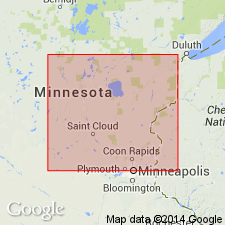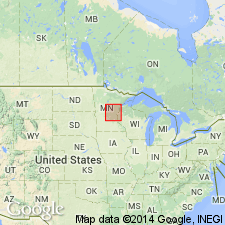
- Usage in publication:
-
- St. Cloud gray granodiorite
- Modifications:
-
- Original reference
- Dominant lithology:
-
- granodiorite
Summary:
Pg. 1002, 1009, 1012-1013, pl. 1. St. Cloud gray granodiorite. Massive but not homogeneous; exposures are dotted with small dark inclusions and schlieren, cut by numerous dikes and veins, and irregularly altered to a lighter pinker rock; this pink facies appears to be granodiorite that was granitized by St. Cloud red granite, dikes and apophyses of which twist and branch irregularly and in some places form a network in the St. Cloud gray granodiorite. One of five major intrusives in late Algoman; these cannot be shown to be members of a single magma series; age relations of the named intrusives, St. Cloud gray granodiorite, Freedhem tonolite, Hillman tonalite, and Warman quartz monzonite, are indeterminate because no contacts are exposed.
Named for the fact that it occurs in vicinity of St. Cloud, Stearns Co., central MN.
Source: US geologic names lexicon (USGS Bull. 1200, p. 3385).

- Usage in publication:
-
- St. Cloud Granite
- Modifications:
-
- Redescribed
- Dominant lithology:
-
- Granite
- AAPG geologic province:
-
- Lake Superior region
Summary:
Is part of Stearns Granitic Complex (redescribed). Redescribed to St. Cloud Granite to account for varied facies names previously used in vicinity of St. Cloud and Waite Park, Stearns County, east-central Minnesota, in Lake Superior region. Prior usage as commercial, informal names now considered inadequate. Name now reflects consolidation of facies previously assigned to "St. Cloud Red", "St. Cloud Gray", and other informal names. Although textural and mineralogic attributes are variable, is divided into three facies: (1) porphyritic, sodic granite; (2) porphyritic, potassic granite, locally pegmatitic; and (3) equigranular, potassic granite facies. Additional border facies (white, porphyritic granite of Woyski, 1949) also recognized along northwestern edge of pluton. Age is middle Precambrian. Report includes geologic map, detailed petrographic descriptions.
Type locality designated where facies 1 through 3 are well exposed, in group of abandoned quarries, in SE/4 sec. 19 and SW/4 sec. 20, T. 124 N., R. 28 W. Presents other localities [as reference?] in Stearns, Benton, and Sherburne Counties.
Source: Modified from GNU records (USGS DDS-6; Denver GNULEX).
For more information, please contact Nancy Stamm, Geologic Names Committee Secretary.
Asterisk (*) indicates published by U.S. Geological Survey authors.
"No current usage" (†) implies that a name has been abandoned or has fallen into disuse. Former usage and, if known, replacement name given in parentheses ( ).
Slash (/) indicates name conflicts with nomenclatural guidelines (CSN, 1933; ACSN, 1961, 1970; NACSN, 1983, 2005, 2021). May be explained within brackets ([ ]).

